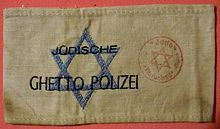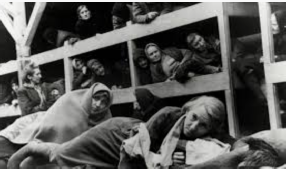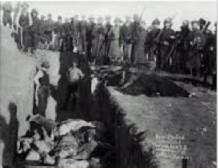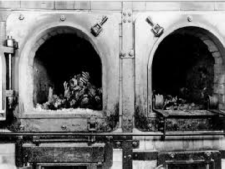|
CLICK BUTTON TO GO |
|
|
|
|
|
|
|
|
|
|
|
|
|
Videos |
|
|
|
|
|
|
|
|
|
|
|
|
|
PART 1 T O P I C |
|
|
|
|
|
|
|
|
|
|
|
|
|
|
|
|
|
|
JewishWikipedia.info

GHETTO POLICE
YIVO Encyclopedia of Jews n Eastern Europe
Officially called the Jewish Organization for the Maintenance of Public Order (Ger., Jüdischer Ordungsdienst; Pol., Żydowska Służba Porządkowa), Jewish police units were established under Nazi occupation in most East European ghettos. The establishment of a police force usually was connected with the creation of the ghettos, which excluded the Jewish population from general police jurisdiction and thus created a need for an alternative system of ensuring that the Jewish population complied with German occupiers’ orders. The absence of a general German order regarding the establishment of the Jewish police indicates that in all probability, it was the various local occupying forces—and not the Central Reich Government—that took the initiative to set up this force. Indeed, the composition of the Jewish police in different ghettos, their jurisdictional powers, and their status within the Jewish community varied from ghetto to ghetto, according to local conditions. A small ghetto could muster only a handful of individuals to join its police force, whereas the Warsaw ghetto police comprised more than 2,000 members.
Ghetto police forces were officially branches of Judenräte (sg., Judenrat) but were also commanded directly by local non-Jewish police authorities and the SS. Therefore, police units in some ghettos became independent of the Judenräte. However, in other places the Judenrat and the ghetto police were indistinguishable. Initially, the primary task of the Jewish police was to maintain public order and to enforce German orders transmitted by the Judenräte to the Jewish population. Municipal authorities retained jurisdiction over criminal matters and disputes between Jews and non-Jews. At this phase, there were Jews who viewed the establishment of the Jewish police positively; some intellectual circles even openly supported it. Jews joined it for social motives and out of a desire to help maintain order in the ghettos and assist Jewish autonomy.
German authorities insisted that Jewish police officers be young, fit, and army-trained, with at least a high school diploma—but those principles were not always followed. Many police were refugees from other Jewish communities and few had been involved in organized Jewish affairs before the war.
Gradually the Germans expanded the workload of the Jewish police, calling upon them to fight epidemics, quell demonstrations, and fight fires. Other times the police were charged with overseeing distribution of foodstuffs and controlling prices as well as collecting taxes. They were part of the battle against those who disobeyed German orders, although the scope of their jurisdiction varied from place to place. Prisons were erected in the larger ghettos and detention rooms in the smaller ones; rarely were inmates transferred to the Germans. In most cases, ghetto police themselves carried out the punishment that ghetto courts imposed on the accused. Sometimes they even assisted in executing German-ordered death sentences.
Police were supposed to be paid by the Judenräte, but often their salary was insufficient and irregular. Thus they were open to bribes, a situation that adversely affected moral standards. Understanding that the Jewish police served to enforce German policy, many left it; their places were taken mainly by people with no obligation to the Jewish population and by other doubtful elements. As standards declined, so did the relationship between the police and the Jewish public, especially after Jewish police began taking part in sending Jews to labor camps in 1940. Ghetto police personnel were generally exempt from labor service and were even empowered to release others from their labor obligations (in exchange for bribes). Guarding the ghetto walls also corrupted the police and placed them in confrontations with the public. Often Jewish policemen worked with local police and even with German soldiers to control smuggling. Their close ties with the German and local authorities and the opportunity for kickbacks led many Jewish communities to identify them with the occupying forces. Over time, corruption became part of the Jewish police identity, and many of them lived lives of luxury amid the remainder of the poor Jewish population. Thus, the original esteem in which the Jewish police were held was replaced with hatred and contempt.
Nonetheless, some police officers tried to improve the lot of the Jewish community, despite harsh German supervision. Several tried to fight corruption and were active in bolstering public supervision over the police force. Other officers intervened with German authorities on behalf of Jews, at times paying with their lives.
The onset of deportations to killing centers in 1942 led to a new phase in the history of the Jewish police. The Germans generally ordered ghetto police forces to assist in deporting Jews and sometimes even on selection. In return, the Nazis assured them that they and their families would not be deported. Police officers who refused to obey the orders joined the deportees or were killed on the spot. In most instances, the police complied with German demands.
During this period, the status of the ghetto police hit an all-time low in Jewish eyes. Even then, however, there were instances when police gave advance warning of expulsions and cautioned Jews to hide. In some ghettos, police actively opposed deportation orders and even made up the core of the armed resistance movement. Most of these ghettos were in the Soviet Union or in the eastern part of Poland occupied by the Soviets from 1939 to 1941. In the Generalgouvernement, by contrast, relations between Jewish police and underground organizations were more often hostile. In both regions, however, there was considerable variation.
The number of police units was greatly reduced in the wake of deportations, and families of former police officers, who until then had been safeguarded, were usually murdered. At the same time, some Jewish underground organizations tried to take revenge on the Jewish police.
At the end of the war, the role of Jewish police and their actions became a highly controversial issue among Holocaust survivors. Dozens of police officers were tried in Jewish honor courts for improper conduct. Some were expelled from the Jewish community while others were merely barred from holding public office. The names of other former officers were cleared. It took years for the courts to decide not to put Jewish police on formal trial.
Some researchers have claimed that in small communities, relations between the Jewish police and the Jewish public were better than those in larger ones. Others have argued that corruption was more widespread in the General government ghettos, whereas police in areas under Soviet control until 1941 generally played a more positive role in ghetto life. The latest studies have shown conclusively, however, that there is no consistent correlation between either the size of the Jewish community or the location of the ghetto and police behavior. A proper evaluation of the Jewish police must be based on the study of each individual ghetto.
JEWISH POLICE
Wikipedia
Jewish Ghetto Police or Jewish Police Service (German: Jüdische Ghetto-Polizei or Jüdischer Ordnungsdienst), also referred to by Jews as the Jewish Police, were auxiliary police units organized within the Jewish ghettos of German-occupied Eastern Europe by local Judenrat councils under the ultimate authority of the Nazi occupiers.[1]
Members of the Jüdischer Ordnungsdienst at first did not have official uniforms, often wearing just an identifying armband a hat, and a badge, and were not allowed to carry firearms, although they did carry batons. They were used by the Germans primarily for securing the deportation of other Jews to the concentration camps, but their work encompassed all forms of public order in the ghetto.
The Jüdischer Ordnungsdienst were recruited from two separate groups, who could be relied upon to follow German orders. The first were Jewish lawyers, disbarred by the Nazi occupiers, largely recruited by deputy commander Jakub Lejkin, himself later killed by the Jewish Resistance. The second, larger and more criminally active group, were recruited from among pre-War Jewish organised crime groups. The first commander of the Warsaw ghetto was Józef Szeryński, a Jewish lieutenant-colonel in the pre-War Polish Police. He changed his name from Szenkman and developed an anti-Semitic attitude. Szerynski survived an assassination attempt carried out by a member of the Jewish police, Yisrael Kanal, who was working on behalf of the underground Jewish Combat Organization. In ghettos where the Judenrat was resistant to German orders, the Jewish police were often used (as reportedly in Lutsk) to control or replace the council.
The criminal elements in the Ordnungsdienst soon came to dominate several areas of life in the ghetto, notably the transportation of people and goods. Additionally, there was a secret department, Section 13, known as the "Jewish Gestapo". It specialised in tracking down Jewish people outside the Ghetto walls, as well as their Polish helpers, and often profited by extorting them.
One of the largest police units was to be found in the Warsaw Ghetto, where the Jüdischer Ordnungsdienst numbered about 2,500. The Łódź Ghetto had about 1,200, and the Lviv Ghetto 500.
The Polish-Jewish historian and the Warsaw Ghetto archivist Emanuel Ringelblum has described the cruelty of the ghetto police as "at times greater than that of the Germans, the Ukrainians and the Latvians." The fate of many of the Jewish Policemen was eventually the same as all other ghetto Jews. Upon the liquidation of the ghettos (1942-1943) they were either murdered on site or sent to the extermination camps. However, some of the more active criminals, especially those associated with the Zagiew network, are known to have survived the War.
(Jewish Ghetto Police, referred to by the jews as the "Jewish Police")
Jewish police units established by the Germans in certain places in the areas under their occupation.
Yad Vashem
The Establishment of the Jewish Ghetto Police Forces
A relatively short time after their establishment, the Judenraete (Jewish councils) in Eastern Europe were ordered to organize these units, usually in anticipation of the ghettoization of the Jews. Whereas the Judenrat itself, although also created on German orders, often contained elements of voluntary association, the Jewish police came into being only on German orders. There was no precedent in the life of the Jewish community for the existence of a Jewish police force, and no indication that independent initiative by Jews in any way played a part in the establishment of the ghetto police. The Germans set guidelines according to which the Judenrat was to recruit the police personnel - physical fitness, military experience, and secondary or higher education. In practice, these guidelines were not always observed. Formally, the Jewish police constituted one of the Judenrat departments, but from the very beginning, many Judenraete were apprehensive about the police department's public character and the way it would function. They suspected that the Germans would have direct supervision of the police and use it for the implementation of their policies. Aware of this danger, many Judenraete sought to establish their own means of controlling the police and the standards of its behavior, and tried to attract to the police young Jews who would be trustworthy.
REASONS FOR JOINING THE POLICE FORCE
At first, some of the recruits did indeed believe that joining the police gave them an opportunity to serve the community. But there were other reasons for joining. Belonging to a protected organization provided immunity from being seized for forced labor. Police service also offered greater freedom of movement and possibilities of obtaining food. A study of the records of over one hundred Jewish police officers in the Generalgouvernement reveals that the Judenraete did not succeed in their efforts to ensure that the police had public credibility. Seventy percent of the men who served in the police force had taken no part in political and community life before the war, and some 20 percent were refugees and strangers to the ghetto population; only 10 percent had participated in community affairs in the prewar period. The Germans themselves often made sure, when the police was set up, that it would be headed by men who would blindly follow their orders.
OPPOSITION TO THE JEWISH POLICE
Some circles in the ghetto population that were not associated with the Judenrat regarded the Jewish police from the outset as an alien body and a potential danger to the community. In many places, youth movements and Jewish political parties did not permit their members to enlist in the police.
SIZE AND STRUCTURE OF VARIOUS POLICE FORCES
The size of the Jewish police force was not fixed, but depended on the size of the Jewish community. Thus, in Warsaw, the Jewish police at first numbered 2,000; in Lvov, 500; in Lodz, 800; in Krakow, 150; and in Kovno, 200. There was no uniform structure for the police units. In the large ghettos, the commanders held officer rank and the units were made up of subdivisions and district stations. The policemen were identified by the different caps they wore and by the unit's designation inscribed on their armband - the yellow badge that they, like all other Jews, had to wear. In the small ghettos where the police consisted of a few men only, no such organizational arrangements were made.
DUTIES
The duties carried out by the Jewish police can be divided into three categories: 1) Duties in response to specific German demands as conveyed to the police by the Germans, via the Judenrat. 2) Duties related to the Judenrat's activities among the Jews that were not directly related to Germand demands. 3) Duties related to the Jewish population's needs. The first two categories included collecting ransom payments, personal belongings, and valuables, as well as taxes; fetching people for forced labor; guarding the ghetto wall or fence and the ghetto gates; escorting labor gangs who worked outside the ghetto; and, as time went on, conducting random seizures of persons to be sent to labor camps and participating in the roundup of Jews for mass deportations. The exclusion of the Jewish population from public services and their isolation in ghettos created serious problems. In the early stage of its existence, the Jewish police attended to sanitary conditions and assisted in the distribution of food rations and aid to the needy. It also helped in the control of epidemics, and the settling of disputes - all this, of course, in addition to complying with German demands. The ghetto population appreciated the Jewish police for these public-welfare activities. However, already at this stage, there were instances of corruption and misconduct among the police. As time went on, the role of the Jewish police in alleviating living conditions in the ghetto was considerably reduced.
DURING THE MASS DEPORTATIONS
The mass deportations to extermination camps, beginning in 1942, affected the families of the men serving in the police, their friends, acquaintances, and fellow Jews, and they had to decide whether or not to stay at their posts. Many decided to quit the force, some in an overt manner, so as to express their identification with their families and with the Jewish population as a whole. Most of the Jewish policemen who made such a decision were subsequently included in the transports that left for the extermination camps. But there were also Jewish police who stayed on their jobs up to the final phases of the ghettos' existence, submitting to German pressure and obediently following orders. At this stage, the Jewish police took on a different complexion. Directly intervening in its administration, the Germans recruited new men into the force, both as officers and rank and file, who had no commitment at all to the Jewish population. Among the Jewish police personnel were many refugees with no ties to the surviving remnants of the local Jewish community, as well as men of dubious reputation. In numerous ghettos where the Judenrat was not prepared to submit blindly to German orders, it was the Jewish police that gained in strength, to the extent that it was able to control the Judenrat or simply take its place.
THE ATTITUDE OF THE JEWISH POLICE TOWARD THE GHETTO UNDERGROUNDS
The attitude of the Jewish police toward the ghetto underground took on three different forms: The most common relationship was one of tension. In several ghettos - such as those of Bedzin, Sosnowiec, Krakow, and Warsaw - the Jewish police tried to do away with the underground (which is not to say that all members of the police in these places took part in such efforts). In Warsaw in August 1942, during the mass deportations, the Jewish police commander, Joseph Szerynski, was attacked by the underground and seriously wounded. His successor, Jacob Lejkin, was assassinated in October of that year, on orders of the Zydowska Organizacja Bojowa (Jewish Fighting Organization; ZOB). There were instances when the Jewish police followed a policy of nonintervention in the activities of the underground that sometimes took on the form of "benign neglect."
The Jewish Order Police (Holocaust Ghettos) Holocaust Education & Archive Research Team
Nazi Authorities Dissolve Judenrat and Jewish Police in Warsaw Ghetto
Jewish Telegraphic Agency
Go to
THE JUDENRATE
|
|
(Jewish Ghetto Police, referred to by the jews |
HOLOCAUST
GHETTO (JEWISH) POLICE



THE
INCREDIBLE
STORY OF THE JEWISH PEOPLE
THE DACHSHUNDS. JEWISH POLICE
IN THE WARSAW GHETTO
DURING THE GROSS-AKTION IN 1942.
Pro Patria Poland Team 2019 (4.36)
Dachshunds - that's how Warsaw Jews talked about the Jewish police in the Warsaw Ghetto, which in the summer of 1942 helped the Germans
in the great deportation of the Jews to the
Treblinka extermination camp.
From that time, Jewish policemen were called "dachshunds" in the Warsaw ghetto. Because they were able to enter the smallest of holes, to take out hiding Jews from wardrobes, hidden rooms, hiding places, shelters and basements.
NOTE
These comments should be viewed in conjunction with the analyses below.
JEWISH POLICE
(JÜDISCHE GHETTO-POLIZEI)
BEATING JEWS IN THE GHETTO
ConradKemp 2018 (23.46)
